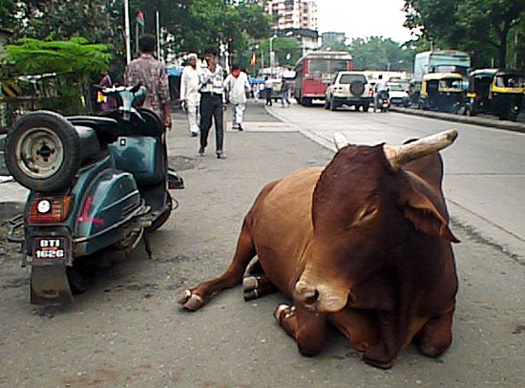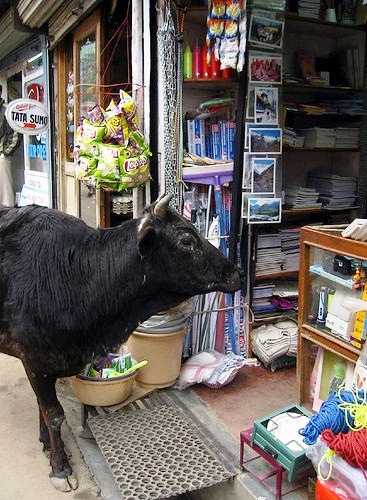An American Teacher Journeys to India
My life with the sacred cows
By Margaret Campbell

Photo by Cris Pedregal
They’re lovely creatures. Docile. No wonder they’re sacred here, in India, where I live and work. They come in every shape, color and size. Their horns are baroque. And, I learned recently, they’re not the major source of milk here – that’s the domesticated water buffalo – also lovely creatures with back-swept horns and a confident tilt to their chins. There’s nothing more charming to me than to see a buffalo soaking contentedly in a rice paddy on a hot, hot, hot day.
The thing is, although I’ve become very fond of them, the cows don’t return my affections. In fact, it really irritates them when I pet them. They do like to be fed, though. Did you know they love bananas? And cardboard? They have the most muscular purple tongues that curl around my hand to loop a treat into their mouths.
The sacred animals of India
Everyone knows about sacred cows, but it isn’t just about the cows. Monkeys are revered, in spite of causing havoc in the cities. The monkey god, Hanuman, plays a heroic role in the Hindu pantheon, so it’s a beloved pastime to feed them, especially at Hanuman’s temples where they have learned there’s always free lunch. Buses stop along rural roads and passengers disgorge to share their travel snacks.
I’ve read that 40 percent of Indians are vegetarians and that 70 percent of the world’s vegetarians live in India. Jains, an ancient religious sect, operate animal shelters all across India, and avoid lighting candles or eating root vegetables because of the risk of damaging small insects. There are groups that try to change the culture around how chickens should be carried (not upside down by the feet, please, or tied to a bicycle) and somebody thought to put up a Street Dogs of India Facebook page.
On the other hand, millions of street dogs, or “free ranging urban dogs” as a contributor to Wikipedia styles them, live as pariahs, largely untreated for injury and disease. While only a small fraction survives to adulthood and there is no shortage of misery, a few do appear to thrive. Some have rapport with “their” humans or they sport collars and are kept as pets. All look blissful sacked out on a bit of sand in the heat of the day, but it would be stupid to pet them. Rabies is common in India, often spread by dogs to children. Or to people like me who just can’t resist a fuzzy snout. Nobody likes cats. I used to joke that cats just don’t do well on a diet of lentils, but you’d think they’d grow fat on all the creepy crawly things around. The few I have seen were young, thin and fast.
Are Indians animal lovers?
 It’s a conundrum. Are Indians animal lovers? I had this discussion with a colleague. She said yes, I said no. I guess it depends upon how you look at it. In the United States we have deep feelings about animals as pets.
It’s a conundrum. Are Indians animal lovers? I had this discussion with a colleague. She said yes, I said no. I guess it depends upon how you look at it. In the United States we have deep feelings about animals as pets.
In India, it’s true that some people in the burgeoning middle class keep dogs as pets – in the remote and rural town where I live, it seems every wealthy house has an American Eskimo dog yapping behind the gate. (I’m not kidding. American Eskimo. It was 107 degrees here last week.) But most of India is not yet middle class. Estimates vary widely, but perhaps 800 million of India’s 1.3 billion citizens are laboring mightily to avoid going to bed hungry.
In this world, dogs and cats fend for themselves on the streets for their brief lives. Cows are protected by law and by custom, but they function as hard-working cogs in the rounds of rural Indian life, providing milk, plowing fields, pulling carts and producing more cows. When they get too old to work, some are abandoned to fend for themselves along the roads and in the cities.
One novel aspect of my experience as a foreigner here is how people’s relationship with animals is colored by their position in the caste system – a hierarchy of social classes based on occupation.
Animals and the caste system
The people who work with animals are at the bottom rungs of the ladder. They are agricultural laborers, herdsmen and leather workers, among other livelihoods. They are typically poor, do not have the luxury of keeping pets and have few table scraps to share with an animal friend, even if revered.
The upper classes are priests and scholars, and typically strict vegetarians. Although caste is not synonymous with economic status, the upper classes tend to have the advantages of better education, better nutrition and all the other driving forces that help people get regular jobs and own property.
Although western influences are visible across India’s social and economic spectrum, it is perhaps most evident in the middle class, especially in the cities where it’s possible to buy packaged pet food and dog treats. I was dismayed to discover, having visited the city of Bhopal and brought home a large packet of chew sticks for the dog pack that lives around my house, that they are confused by the product. It smells like food, but you have to chew it so long! Totally unsatisfying.
Which brings me back to cows. Tonight as I was walking home with a bucket of manure for my garden, a bossie along the road turned and followed me with the most delighted expression on her face. I realized that she saw the bucket and assumed it was leftover rice for her and I had to tell her, “No, dear. This is not for you, it’s from you.” It reminded me of how beautifully integrated we are in the web of life, the cows and I.
~~~~~~~~~~~~~~~~~~~~~~~~~~~~
 Margaret Campbell is an animal lover and human performance executive living and working in remote and rural India. Formerly a dog trainer, equestrian sport competitor, high school teacher, management consultant and single mother, she explains that everything she has ever been successful at derives from one core competency: “It’s all about applying persuasion practices to achieve results in situations where you really don’t have control. When you have teenagers you’ll understand this better!”
Margaret Campbell is an animal lover and human performance executive living and working in remote and rural India. Formerly a dog trainer, equestrian sport competitor, high school teacher, management consultant and single mother, she explains that everything she has ever been successful at derives from one core competency: “It’s all about applying persuasion practices to achieve results in situations where you really don’t have control. When you have teenagers you’ll understand this better!”
